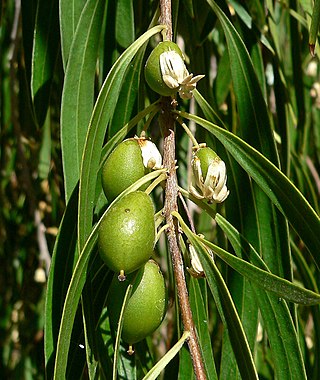
Chamaenerion angustifolium is a perennial herbaceous flowering plant in the willowherb family Onagraceae. It is known in North America as fireweed and in Britain and Ireland as rosebay willowherb. It is also known by the synonyms Chamerion angustifolium and Epilobium angustifolium. It is native throughout the temperate Northern Hemisphere, including large parts of the boreal forests.

Crinum is a genus of about 180 species of perennial plants that have large showy flowers on leafless stems, and develop from bulbs. They are found in seasonally moist areas, including marshes, swamps, depressions and along the sides of streams and lakes in tropical and subtropical areas worldwide.

Eriophorum angustifolium, commonly known as common cottongrass or common cottonsedge, is a species of flowering plant in the sedge family, Cyperaceae. Native to North America, North Asia, and Europe, it grows on peat or acidic soils, in open wetland, heath or moorland. It begins to flower in April or May and, after fertilisation in early summer, the small, unremarkable brown and green flowers develop distinctive white bristle-like seed-heads that resemble tufts of cotton; combined with its ecological suitability to bog, these characteristics give rise to the plant's alternative name, bog cotton.

Crinum latifolium is a herbaceous perennial flowering plant in the amaryllis family (Amaryllidaceae). It arises from an underground bulb. The flowering stems are stout, reaching about 2 m in height. The leaves are long, linear and ligulate. The flowers are white and arranged in an umbel. It grows naturally in Asia, from India and Sri Lanka through much of mainland Southeast Asia to south China. It is also reportedly naturalized in the West Indies and in the Chagos Archipelago.

Crinum pedunculatum also known as the swamp lily, river lily or mangrove lily, is a bulbous perennial found in stream and tidal areas of the Northern Territory, Queensland and New South Wales, Australia as well as New Guinea and some Pacific Islands. It is unclear whether it is native or introduced to Norfolk Island.

Crinum bulbispermum is a herbaceous plant native to South Africa, Lesotho and Eswatini. It is naturalized in the Lesser Antilles, Honduras, Cuba, Florida, Texas, Louisiana, Alabama, South Carolina and North Carolina. Crinum bulbispermum is the floral emblem of the Free State province of South Africa.

Crinum asiaticum, commonly known as poison bulb, giant crinum lily, grand crinum lily, or spider lily, is a plant species widely planted in many warmer regions as an ornamental. It is a bulb-forming perennial producing an umbel of large, showy flowers that are prized by gardeners. However, all parts of the plant are poisonous if ingested. Some reports indicate exposure to the sap may cause skin irritation.

Hypocalymma angustifolium, commonly known as white myrtle, or pink-flowered myrtle, is a species of flowering in the myrtle family Myrtaceae, and is endemic to the south west region of Western Australia. The Noongar peoples know the plant as koodgeed or kudjidi. It is an erect, multi-stemmed shrub with narrowly linear leaves, white or pale pink flowers.

Xylomelum angustifolium, the sandplain woody pear, is a tree species in the family Proteaceae, endemic to Western Australia. A mature Xylomelum angustifolium grows from 2 to 7 metres, though trees up to 10m have been observed. Produces cream flowers between December and February though flowering can commence as early as September in its northern range.

Brithys crini, the amaryllis borer, crinum borer, lily borer or Kew arches, is a moth of the family Noctuidae. It is a garden pest in parts of its range, as their larvae damage the stems and leaves of lilies, especially lilies of the family Amaryllidaceae.

Pittosporum angustifolium is a shrub or small tree growing throughout inland Australia. Common names include weeping pittosporum, butterbush, cattle bush, native apricot, apricot tree, gumbi gumbi, cumby cumby, meemeei, poison berry bush, and berrigan.

Pittosporum phillyreoides, with the common names weeping pittosporum and willow pittosporum, is a shrub or small columnar tree in the Apiales order, endemic to Australia.

Ogyris amaryllis, the amaryllis azure or satin azure, is a butterfly in the family Lycaenidae. It is found in Australia.
The Gregory Coal Mine is an open-cut coal mine located at Crinum, 60 km north east of Emerald in Central Queensland, Australia. The mine has coal reserves amounting to 159 million tonnes of coking coal, one of the largest coal reserves in Australia and the world. The Bowen Basin mine has an annual production capacity of 5 million tonnes of coal. Operations at the Gregory mine started in 1979. Coal from the mine is exported to the Port of Gladstone via the Blackwater railway system.

Crinum moorei is a herbaceous plant belonging to the family Amaryllidaceae, and native to South Africa.

Robert Ramsay was a member of the Australian Queensland Legislative Council, the Queensland Legislative Assembly, and the eighth Treasurer of Queensland.

Crinum flaccidum, known variously as the Darling lily, Murray lily or Macquarie lily, is a species of the family Amaryllidae native to inland Australia. The Darling river people — the Paakantyi — called this plant paalampaltharu.
Crinum is a rural locality in the Central Highlands Region, Queensland, Australia. In the 2021 census, Crinum had a population of 86 people.
The BHP Mitsubishi Alliance (BMA) is an Australian coal mining company operating in Central Queensland. The largest coal producer in Australia, it is a joint venture with BHP and Mitsubishi each owning 50%. It was established in 2001.
















